Eduardo Ormaeche, Birding Ecotours
I recently received an email from my main office asking me to write an article about birding in the neotropics. My immediate question was ‘Any particular topic?’ to which they replied ‘You know what? Write the article on your favorite birding destination in the neotropics’. ‘What is my favorite neotropical birding destination?’ This is one of the most frequently asked questions but also one of the most difficult to answer.
With 20 years of bird and natural history guiding in my native Peru, I should rightly put it above all others, however over these years I have had the opportunity to visit and guide frequently in more than a dozen other Latin American countries which makes the answer even more difficult. I simply love Latin America! I guess to answer this question properly, it depends on the criteria on which the question is asked. Which is the destination I like to guide most which brings me the most birding and wildlife joy? The destination that can provide me with the most lifers? On the other hand, there are certain tours that, despite the fascinating birds, nature and people, are not necessarily the easiest to guide and coordinate logistics.
So how can I choose between the huge ornithological, natural and cultural richness this continent harbors? After thinking about it further and still not finding the answer I decided to walk to my bookshelf, close my eyes, raise my finger and recite ‘Mini, mini, mighty, moe’, by pure chance my finger landed on my Colombian field guide. I smiled to myself and exclaimed ‘Colombia it will be then’.
Facts about Colombia
It is impossible to think about Colombia and not refer to it as a birding paradise! It holds a remarkable 1,993 bird species – the highest country list of any country on Earth – equivalent to 19% of the world’s bird species. If you do want to get a big bird list on a tour to Colombia I recommend visiting any time from the end of November to the end of March, as discussed in our blog ‘When to visit Colombia’.
Despite the incredible richness of Colombia, the country did not receive many tourists or international birders for many years, as a consequence of the civil war, internal terrorism and rampant drug trafficking. Fortunately, those times are well in the past, and within two decades, Colombia has become one of the top wildlife destinations in the neotropics, with well-developed birdwatching facilities found throughout the country. Since the boom in birding tourism, with birders targeting the many amazing endemics and range-restricted species, locals have taken advantage of this opportunity to generate income. Together with the knowledge of a handful of local ornithologists, birders and conservation NGOs, several routes have been developed where you can travel and enjoy Colombian birding.
As more and more local people are getting involved in birdwatching these days, there are new private reserves as well numerous bird-feeding stations popping up all over the country. These bird-feeding stations in particular provide access to species which we could only dream about seeing in the past, including the likes of the enigmatic Hooded Antpitta Grallaricula cucullata and the striking and endemic Multicolored Tanager Chlorochrysa nitidissima.
Due to the huge diversity of bird species on offer, you can do multiple trips to the country and still come back with masses of lifers. Some areas are more visited than others and even today (after many years of exploration) birders and ornithologists are still discovering new species of birds most years. The recently described Antioquia Wren Thryophilus sernai and Antioquia Brushfinch Atlapetes blancae are two such examples, both discovered in recent years. New expeditions to the remote Amazon Rainforest, the Serrania de Chiribiquete and the Pacific Forest on the Panama border (some areas that have not been surveyed in the last 25 years) will almost certainly reveal more undescribed taxon and new species in the near future. However, let’s focus on the easy and feasible routes.
What makes Colombia particularly easy to travel around is the fact that it is one of the few Latin American countries which can be accessed through four different international airports (Bogotá, Medellín, Calí and Barranquilla). This means you are not forced to fly in and out from a single airport, thus making traveling quicker and easier.
What are the Colombian highlights?
We have talked about numbers which some people might think are interesting, but we are not all impressed by numbers alone. So why not name some classic and iconic species to catch your attention (also see our Colombian birding blog here); and what better way to start than with perhaps the most colorful and eye-catching group of them all – tanagers!
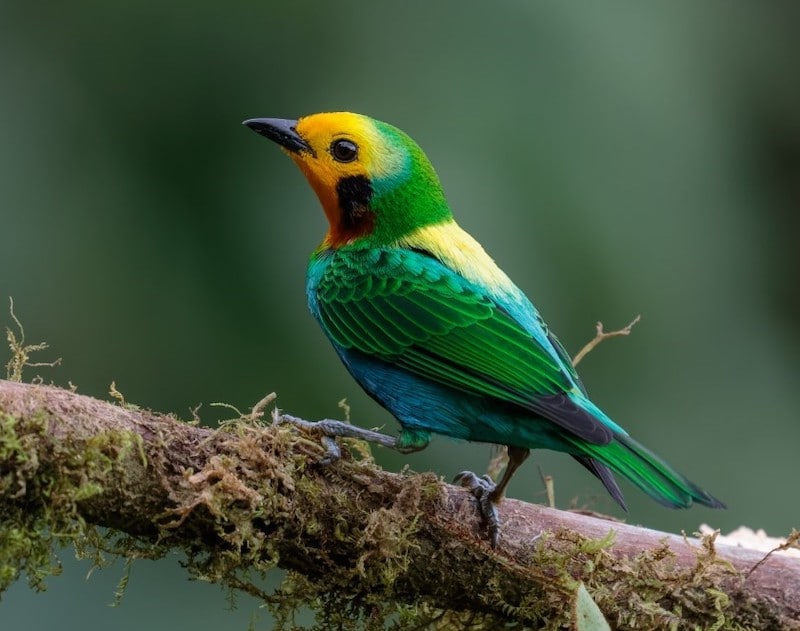
The striking Multicolored Tanager Chlorochrysa nitidissima is endemic to Colombia © Daniel Orozco
A trip across the western and central Andes of Colombia can provide you with Multicolored Tanager Chlorochrysa nitidissima, one of the most beautiful species of tanagers, whose beauty may only be rivalled by a few of the Atlantic Forest tanager species. Colombia is full of incredible tanagers such as the endemic Gold-ringed Tanager Bangsia aureocincta and Black-and-gold Tanager Bangsia melanochlamys and other mouth-watering species such as Scarlet-and-white Tanager Chrysothlypis salmoni , Blue-whiskered Tanager Tangara johannae, Moss-backed Tanager Bangsia edwardsi, Glistening-green Tanager Chlorochrysa phoenicotis, Golden-chested Tanager Bangsia rothschildi, Lemon-spectacled Tanager Chlorothraupis olivacea, Paradise Tanager Tangara chilensis, White-capped Tanager Sericossypha albocristata and Yellow-collared Chlorophonia Chlorophonia flavirostris among the many other tanager species found in adjacent countries.

Scarlet-and-white Tanager Chrysothlypis salmoni © Gilberto Collazos
What else?
What about cotingas? This impressive and distinctive South American family is well represented in Colombia, with perhaps one of the most highly desired neotropical species, being a member of this family – the Andean Cock-of-the-Rock Rupicola peruvianus. Yes, this gorgeous-looking bird you saw as a child in bird and wildlife cards inhabits the forests of Colombia, and is found in good numbers too. In fact, Colombia has both species of cock-of-the-rocks. The Andean Cock-of-the-Rock is found in the lush forests of Los Farellones National Park and the famous cock-of-the-rock lek in Jardin, in the Antioquia region, while the Guianan Cock-of-the-Rock Rupicola Guiana is found on the eastern slopes of the Andes in the Guaviare Province, as well as Mitú and Inirída. Other jewels from this spectacular family include Black-tipped Cotinga Carpodectes hopkei, Orange-breasted Fruiteater Pipreola jucunda, Scaled Fruiteater Ampelioides tschudii, Long-wattled Umbrellabird Cephalopterus penduliger, Capuchinbird Perissocephalus tricolor, Pompadour Cotinga Xipholena punicea and Chestnut-bellied Cotinga Doliornis remseni – all good reasons to explore this fabulous country.
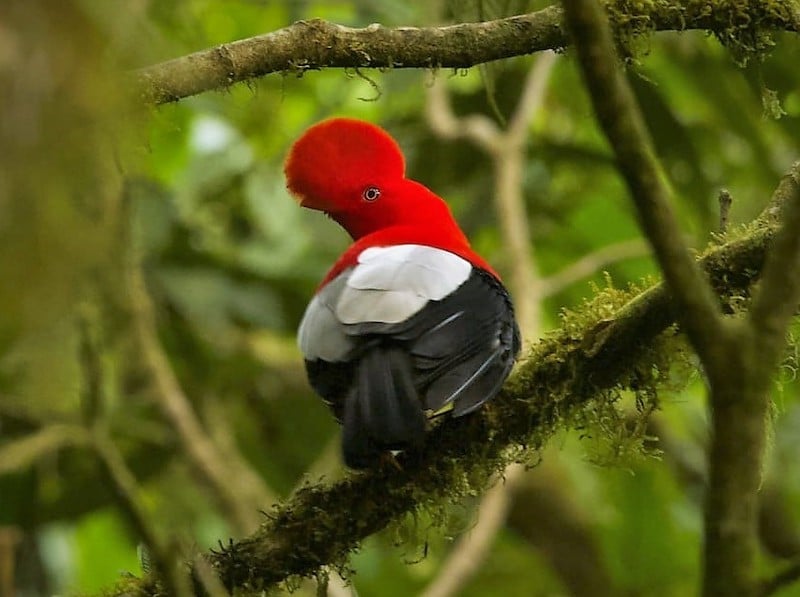
Andean Cock-of-the-Rock Rupicola peruvianus © Galo Real
There is no doubt that hummingbirds are one of the most charismatic bird families of the neotropics, with Colombia being blessed with an amazing 168 species! You can get an average of 65-75 hummingbird species on a 3-week trip, if you know where to go and visit the most important hummingbird feeding stations and habitat – here iconic species such as Sword-billed Hummingbird Ensifera ensiform can appear seemingly out of nowhere, right in front of your eyes. You will enjoy such species as the more common White-necked Jacobin Florisuga mellivora to scarcer jewels like Violet-tailed Sylph Aglaiocercus coelestis, Black Inca Coeligena prunellei, Blue-throated Starfrontlet Coeligena helianthea, Ruby-topaz Hummingbird Chrysolampis mosquitus, Buffy Hummingbird Leucippus fallax, Indigo-capped Hummingbird Saucerottia cyanifrons, Tooth-billed Hummingbird Androdon aequatorialis and Green-bearded Helmetcrest Oxypogon guerinii to name but a few.
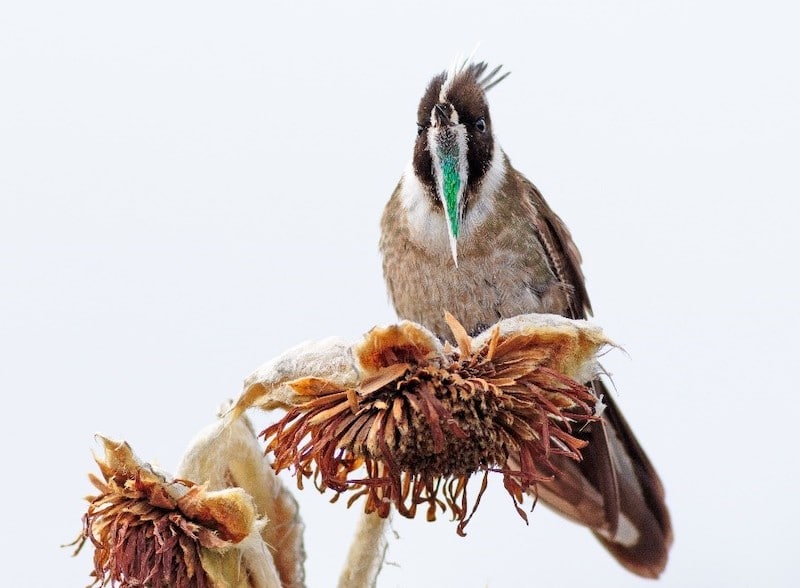
Green-bearded Helmetcrest Oxypogon guerinii is an endemic hummingbird found in paramos habitat outside of Bogotá © Daniel Orozco
Not enough?
The Ecuadorian, Mr. Angel Paz can claim to be the first person to ever feed the elusive Grallariidae (antpitta) family with any success which started the antpitta feeding station boom in Ecuador, with Colombia soon following suit. The first antpitta feeding stations in Colombia were introduced to the Rio Blanco Reserve in the mountains of Manizales in the central Andes. Here under the management and skill of Mr. Albeiro Uribe, visitors can lay eyes on some endemic and tough-to-see species such as Brown-banded Antpitta Grallaria milleri, Chestnut-naped Antpitta Grallaria nuchalis, Chestnut-crowned Antpitta Grallaria ruficapilla, Bicolored Antpitta Grallaria rufocinerea and Slaty-crowned Antpitta Grallaricula nana. In recent years you can see all five locally occurring antpitta species in one hour! It’s just insane!
Today there are other feeding stations around the country to make your visit even more worthwhile, where you can see species such as the sought-after Crescent-faced Antpitta Grallaricula lineifrons, Rufous Antpitta Grallaria rufula and Hooded Antpitta Grallaricula cucullata.
Therefore, if you are an antpitta fan, Colombia is simply a must-visit destination.
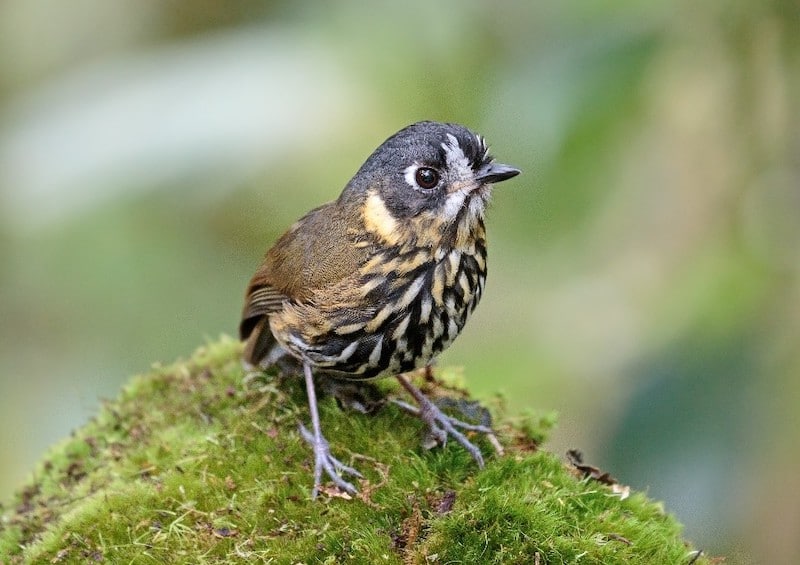
Crescent-faced Antpitta Grallaricula lineifrons one of the most sought-after South America bird species © Daniel Orozco
Glorified Little Brown Jobs
I found it funny the first time I heard the expression ‘Little Brown Jobs’ which refers to small, obscure and difficult-to-identify skulking passerines, and the neotropics are full of them, occupying many different types of habitats and including species such as ovenbirds, tapaculos and antbirds. ‘Oh well another Antbird or other’! A statement I have heard many times but let me tell you, Colombia holds an amazing set of truly handsome and most-wanted ‘Little Brown Jobs’ with some species best searched for in Colombia. Consider Ocellated Tapaculo Acropternis orthonyx? This spectacular bird inhabits the cloudforest from northwest Venezuela across Colombia, Ecuador and into northwest Peru with Colombia offering the best chances for this gem. Other incredible-looking species include the mythical Recurve-billed Bushbird Clytoctantes alixii, Chestnut-crested Antbird Rhegmatorhina cristata, Bare-crowned Antbird Gymnocichla nudiceps, White-bellied Antbird Myrmeciza longipes, White-plumed Antbird, Pithys albifrons, Rusty-headed Spinetail Synallaxis fuscorufa, White-whiskered Spinetail Synallaxis candei and Ocellated Antbird Phaenostictus mcleannani, to name a few examples of what I call ‘Glorified Little Brown Jobs’. Colombia is of course full of these species which can help to build your life list with more endemic species such as Tatama Tapaculo Scytalopus alvarezlopezi, Magdalena Tapaculo Scytalopus rodriguezi, Perija Tapaculo Scytalopus perijanus and a seemingly endless number of antbird species.
Sierra Nevada de Santa Marta
Perhaps one of the more incredible places to visit in South America, from a geographical and ornithological point of view, is the Sierra Nevada de Santa Marta (SNSM) mountain range. An impressive isolated mountain range in northern Colombia that ranges from the Caribbean coast to an altitude of 5,700 meters (18,700 feet) and is one of the more important centers of endemism in South America, with no less than 19 endemic bird species. Visiting SNSM is relatively easy if you fly to Santa Marta and take a 4×4 vehicle to El Dorado Lodge at 1,950 meters (6,400 feet), one of the most charming places in Colombia for birdwatching and a perfect base to explore different elevational habitats. At the lodge, you can enjoy the hummingbird feeders with species such as the endemic White-tailed Starfrontlet Coeligena phalerata, Crowned Woodnymph Thalurania colombica and Lazuline Sabrewing Campylopterus falcatus.
The compost area is great to find birds such as Black-fronted Wood Quail Odontophorus atrifrons, Lined Quail-Dove Zentrygon linearis, Slaty-backed Nightingale-Thrush Catharus fuscater, Yellow-legged Thrush Turdus flavipes, Sierra Nevada Brushfinch Arremon basilicus and Band-tailed Guan Penelope argyrotis. The lodge surroundings are good for Golden-breasted Fruiteater Pipreola aureopectus and White-throated Toucanet Aulacorhynchus albivitta. At night, if you are lucky, you may find the recently described Santa Marta Screech Owl Megascops gilesi an endemic and poorly known owl that gained full species status only few years ago. A decade or so ago, it was relatively easy to find this bird by the cabins or even around the lodge itself however the excess use of playback may have contributed to the birds being less cooperative than in the past.

Santa Marta Screech Owl Megascops gilesi © Anne Koke
The drive up to the San Lorenzo Ridge 2,700 meters (8,850 feet) is something to experience and watching the sunrise from here is simply spectacular. Additionally, the ridge holds most of the Santa Marta endemics such as the Santa Marta Mountain Tanager Anisognathus melanogenys, Santa Marta Warbler Myiothlypis basilica, Santa Marta Antpitta Myiothlypis basilica, Brown-rumped Tapaculo Scytalopus latebricola, Santa Marta Brushfinch Atlapetes melanocephalus, Santa Marta Bush Tyrant Myiotheretes pernix and the Endangered (BirdLife International) Santa Marta Parakeet Pyrrhura viridicata, to name a few.
The habitats below the lodge are good areas to look for Santa Marta Woodstar Chaetocercus astreans, Santa Marta Blossomcrown Anthocephala floriceps, Santa Marta Tapaculo Scytalopus sanctaemartae and Santa Marta Foliage-gleaner Clibanornis rufipectus.
In addition to the Sierra Nevada de Santa Marta, there are other birding sites that feature as some of my favorite Colombian birding destinations that are certainly worth a mention (see below).
My top ten Colombian birding destinations
- Anchicaya (The Old Buenaventura-Cali Road)
This old, unmaintained road connecting the Pacific port of Buenaventura with the city of Cali provides an incredible set of bird species, including many of the colorful tanagers described earlier such as Scarlet-and-white, Blue-whiskered, Golden-chested, Grey-and-gold and Rufous-throated Tanagers. In addition, good Chocó species such as Choco Toucan Ramphastos brevis, Lita Woodpecker Piculus litae, Choco Woodpecker Veniliornis chocoensis, Spot-crowned Barbet Capito maculicoronatus, Lanceolated Monklet Micromonacha lanceolata and if you are particularly lucky, the rare Berlepsch’s Tinamou Crypturellus berlepschi.
- Tatama National Park (Montezuma)
Definitely high on my list of places to visit. The diversity of birds here is simply outstanding! It might not work for those who are keen on fancy accommodation but for birdwatchers who are less worried about these things, it is absolute paradise. Exploring the higher elevations provides you with species such as the endemic Chestnut-bellied Flowerpiercer Diglossa gloriosissima and Munchique Wood Wren Henicorhina negreti. Additionally, the area hosts Tanager Finch Oreothraupis Arremonops, Chestnut-breasted Chlorophonia Chlorophane pyrrhophrys, Beautiful Jay Cyanolyca pulchra and if you are lucky, White-faced Nunbird Hapaloptila castanea. The park is one of the few places to target the seldom-seen Greater Scythebill Drymotoxeres pucheranii – one of the holy grail species of South American birding. The list follows with Club-winged Manakin Machaeropterus deliciosus, the endemic Gold-ringed Tanager Bangsia aureocincta, Black-and-gold Tanager Bangsia melanochlamys, Choco Vireo, Vireo masteri Black Solitaire Entomodestes coracinus, Dusky Starfrontlet Coeligena orina, Olive Finch Arremon castaneiceps and many more. Here we can expect delicious homemade food and friendly faces.
- Rio Blanco Reserve
A classic Colombian birding destination and excellent for mixed-species flocks (if you don’t have a sunny day) when you can score with incredible birds such as Masked Saltator castanosides cinctus, Dusky Piha Lipaugus fuscocinereus, White-capped Tanager Sericossypha albocristata, Black-billed Mountain Toucan Andigena nigrirostris, Rufous-crowned Tody-Flycatcher Poecilotriccus ruficeps, Golden-plumed Parakeet Leptosittaca branickii and Yellow-vented Woodpecker Veniliornis dignus. This reserve was the first Colombian place to utilize antpitta feeding stations. It’s also a great spot for night birds (if you stay at the reserve) including the likes of Band-winged Nightjar Systellura longirostris, Lyre-tailed Nightjar Uropsalis lyra, Rufous-bellied Nighthawk Lurocalis rufiventris, White-throated Screech Owl Megascops albigularis and if you are lucky, Stygian Owl Asio stygius at its daytime roost.
- Observatory of Hummingbirds (Observatorio de Colibríes in Spanish)
Located roughly 40 kilometers (1-2-hour drive) from Bogotá Airport, this private house with its charming gardens hosts a fabulous set of hummingbird species which visit its many feeders. The feeders mostly attract high-elevation hummingbird species such as the incredible Blue-throated Starfrontlet, Great Sapphirewing Pterophanes cyanopterus, Green-tailed Lesbia nuna and Black-tailed Trainbearer Lesbia victoriae, Sword-billed Hummingbird, Coppery-bellied Puffleg Eriocnemis cupreoventris, Glowing Puffleg Eriocnemis vestita, Tyrian Metaltail Metallura tyrianthina, Lesser Violetear Colibri cyanotus, Sparkling Violetear Colibri coruscans, White-bellied Woodstar Chaetocercus mulsant and Longuemare’s Sunangel Heliangelus clarisse.
- Andean Cock-of-the-Rock Lek (Jardin de Antioquia)
Even though this place does not hold many other species and there are countless other Andean Cock-of-the-Rock Rupicola peruvianus leks in South America, the one in Jardin de Antioquia is by far the best of them all. The males are incredibly hyperactive as they perform their fabulous natural show. The blind/hide here has ample room for several people, is set up to cater for photographers and has better light (for photography) than other lek sites in Colombia.
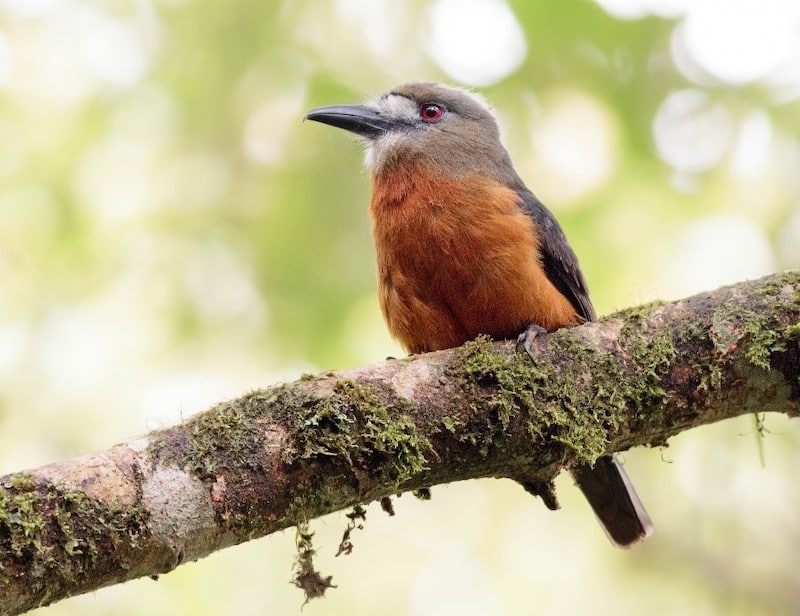
White-faced Nunbird Hapaloptila castanea can be seen with some luck in the Tatama National Park ©Daniel Orozco
- Mitú Lowlands
Located in the Vaupés Department in southeast Colombia these lowlands offer some exciting and remote birding opportunities. Although not perhaps my favorite place to lead a tour (due to the difficult logistics), if you have someone to arrange these things for you, the place is highly recommended, especially for those looking for range-restricted species of the Amazon and Orinoquia basin. Some of the special birds that can be found here include Tawny-tufted Toucanet Selenidera nattereri, Guianan Cock-of-the-Rock Rupicola Selenide, Pompadour Cotinga Xipholena punicea, Red-fan Parrot Deroptyus accipitrinus, Black Bushbird Neoctantes niger, Chestnut-crested Antbird Rhegmatorhina cristata, Grey-bellied Antbird Ammonastes pelzelni, White-bellied Dacnis Dances albiventris, Imeri Warbling Antbird Hypocnemis flavescens, Fiery Topaz Topaza pyra, Azure-naped Jay Cyanocorax heilprini, Orinoco Piculet Picumnus pumilus and White-chested Puffbird Malacoptila fusca, to name a few. It’s old school birding here with the hard work will being well rewarded, especially if you are building a Colombia list – just be prepared to walk most of the day in humid rainforests!
- Finca Alejandria
Located conveniently close to Cali, this classic Colombian birding destination offers some easy and incredibly productive birding. A private property with an amazing amount of fruit and sugar feeders where you can see many species of birds at point-blank range. These well-positioned bird feeders make it a good place for studying different age and sex-related bird plumages, capturing that perfect image or enjoying some relaxed birding. Some of the species that visit the feeders daily include Red-headed Barbet Eubucco bourcierii, Crimson-rumped Toucanet Aulacorhynchus haematopygus, Golden-eared Tanager Tangara chrysotis, Saffron-crowned Tanager Tangara xanthocephala, Golden Tanager Tangara arthus, Green Honeycreeper Chlorophanes spiza and Golden-naped Tanager Chalcothraupis ruficervix however the star here is the Multicolored Tanager Chlorochrysa nitidissima. Other special birds that can be hoped for include Colombian Chachalaca Ortalis columbiana, Golden-headed Quetzal Pharomachrus auriceps and even Ornate Hawk-Eagle Spizaetus ornatus. Of the hummingbirds, there are several species to search for here including Long-tailed Sylph Aglaiocercus kingii and Bronzy Inca Coeligena coaligned with perhaps the most special being the Blue-headed Sapphire Chrysuronia grayi. You can enjoy all of the above fantastic species while sipping a nice, warm cup of Colombian coffee.
- Otún-Quimbaya Flora and Fauna Sanctuary
An interesting bird reserve located just 24 kilometers from Pereira airport (1-hour drive), in the central Andes where you have the chance of spending a relaxing day or two looking for species like the endemic Cauca Guan Penelope perspicax and the enigmatic Hooded Antpitta Grallaricula cucullata. Otún Quimbaya is perhaps the best place in South America to look for Red-ruffed Fruitcrow Pyroderus scutatus which is often found along the main road and around the cabins of the lodge. Other good species include Rufous-breasted Flycatcher Leptopogon rufipectus, Chestnut Wood Quail Odontophorus hyperythrus, Parker’s Antbird Cercomacroides parkeri, Whiskered Wren Pheugopedius mystacalis, Andean Motmot Momotus aequatorialis and Stiles’s Tapaculo Scytalopus stilesi. If you are lucky, you might encounter the secretive Moustached Antpitta Grallaria alleni and the seldom-seen Mountain Tapir Tapirus pinchaque. The river almost always provides a family of Torrent Ducks Merganetta armata and White-capped Dippers Cinclus leucocephalus.
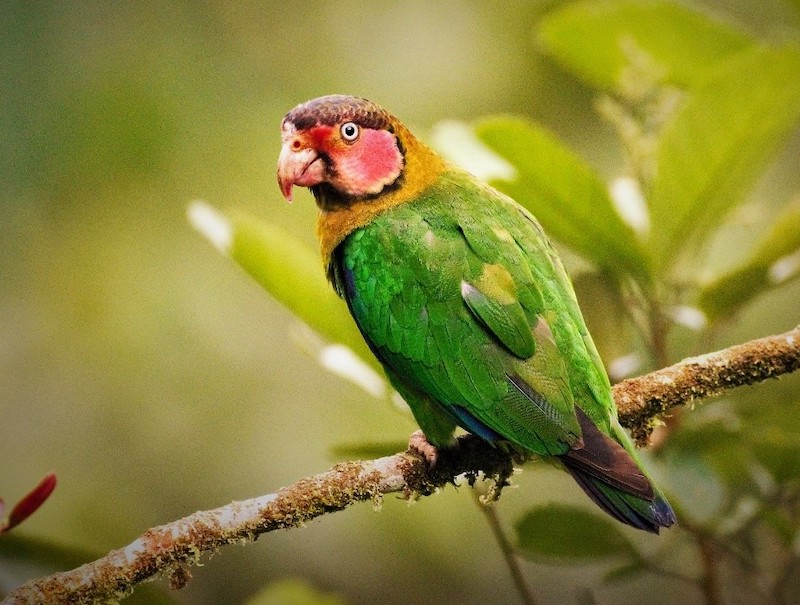
Rose-faced Parrot Pyrilia pulchra one of the exquisite species you can see along the Anchicaya Road © Gilberto Collazos
- Juan Solito Ecolodge, Yopal
The Colombian Llanos is a paradise for bird and wildlife lovers alike, with an abundance of wildlife and birds. The Llanos is a completely different habitat to anything else found throughout the country – a vast tropical savanna. Definitely one of my favorites as I enjoy birding this wonderful habitat type in other parts of South America such as in the Pantanal (Brazil), Bolivia and Argentina. In los Llanos, you can get large numbers of water birds including large flocks of Scarlet Ibis Eudocimus ruber, Sharp-tailed Ibis Cercibis oxycerca, Crestless Curassow Mitu tomentosum, Orinoco Goose Neochen jubata, Snail Kite Rostrhamus sociabilis, Black-collared Hawk Busarellus nigricollis and two other specials Pale-headed Jacamar Brachygalba goeringi and White-bearded Flycatcher Manacus manacus. With luck, you could score some mega fauna such as Lowland Tapir Tapirus terrestris, Giant Anteater Myrmecophaga tridactyla, Anaconda Eunectes murinus and even Jaguar Panthera onca. Juan Solito Ecolodge offers daily safari drives to look for all the above amazing wildlife.
- El Paujil Reserve on the Magdalena River
Located a roughly 6-hour drive from Medellín, this reserve offers you the chances of seeing some great species such as the Critically Endangered (BirdLife International) Blue-billed Curassow Crax alberti and Magdalena Valley specials such as the endemic White-mantled Barbet Capito hypoleucus, Beautiful Woodpecker Melanerpes pulcher, Black-billed Flycatcher Aphanotriccus audax and Sooty Ant Tanager. The most-wanted Northern Screamer Chauna chavaria is often seen on the way to the lodge, together with flocks of Blue-and-yellow Macaws Ara ararauna. At night, you can look for Spectacled Owl Pulsatrix perspicillata, Choco Screech Owl Megascops centralis and Great Potoo Nyctibius grandis. Furthermore, the area is an absolute paradise for those who enjoy photographing reptiles and amphibians.

Beautiful Woodpecker Melanerpes pulcher, an endemic of the Magdalena Valley which can be found at El Paujil Reserve © Daniel Orozco
The above birding highlights are are just a few examples of what Colombia has to offer. The country is full of bird reserves and I still need to make my way back to explore other new reserves which offer further incredible birding opportunities such as Isla Escondida in the southern Amazon and the Urabá Lowlands near the Darien border.
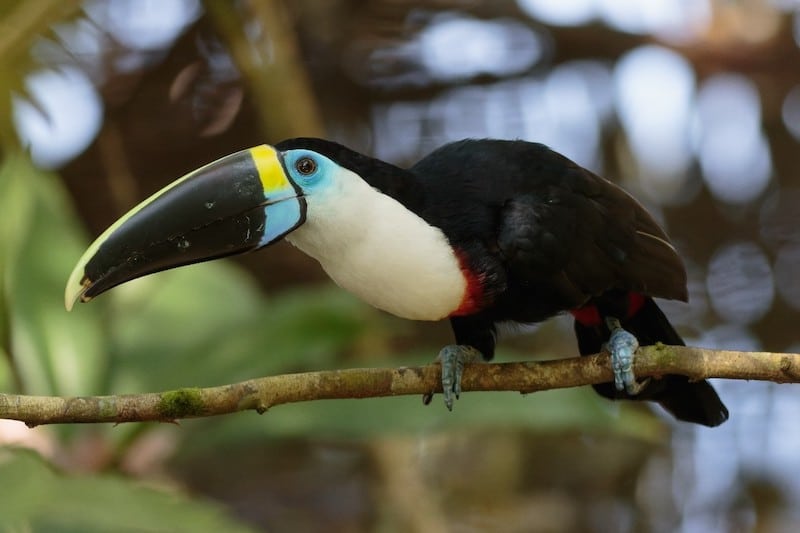
White-throated Toucan Ramphastos tucanus can be seen in the Amazon lowlands © Daniel Orozco
